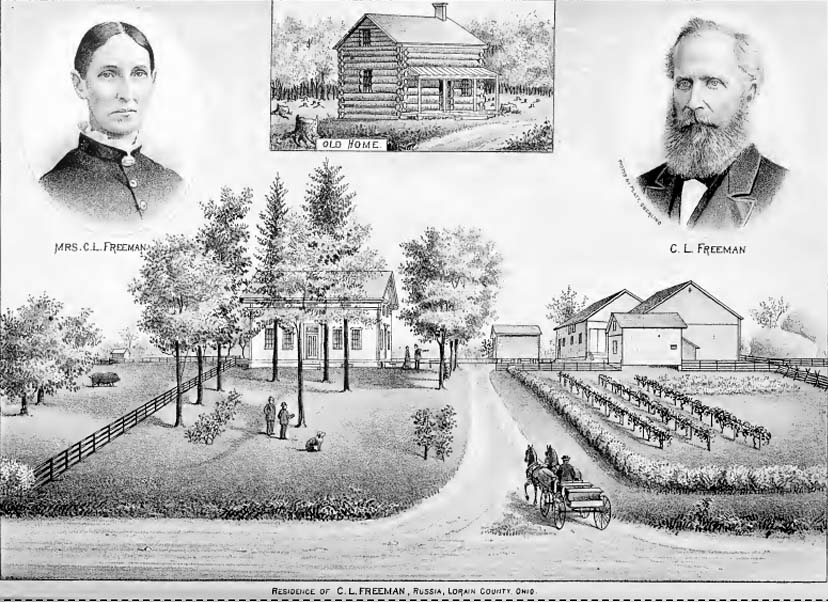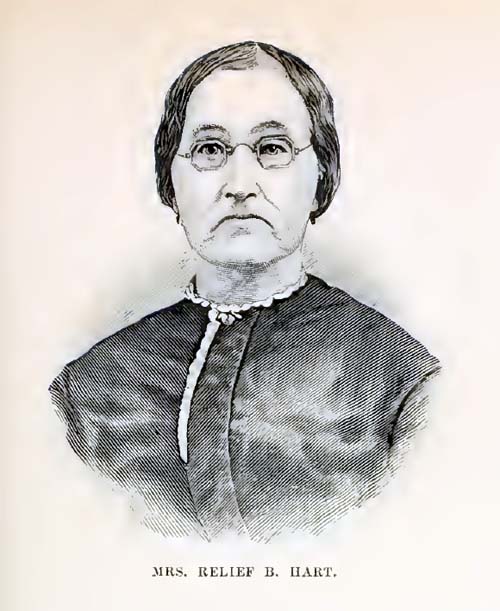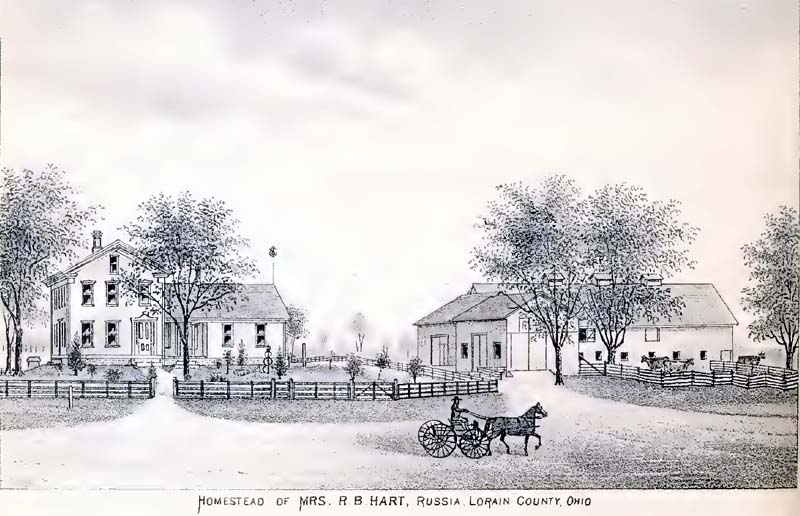|

OBERLIN.
PREFATORY NOTE.
The
following sketch of Oberlin history is mainly a
compilation, but it may be regarded as reliable, and
is as complete as the scopy of this work will admit.
The facts and documents pertaining to the early
history, I have taken chiefly from the "History of
Oberlin," in manuscript, by President Fairchild;
of which, availing myself of the generous offer of
the author, I have made free use. Other facts
and statistics have been taken form the college
catalogues, from articles in the Oberlin
Evangelist and in the Oberlin Review, and
from other sources, for my indebtedness to which,
this general acknowledgment must suffice. For
the estimates of Oberlin, and of a fw of its leading
men, the writer is alone responsible.
H. M.
LIBRARY OBERLIN COLLEGE, December 30, 1878.
INTRODUCTION
I. - ORIGIN.
The origin
of Oberlin is due to two men, John Jay Shipherd
and Philo Penfield Stewart, the inventor of
the well-known Stewart store. Mr. Shipherd
was a native of New York, and Mr. Stewart
of Connecticut. In 1830, Mr. Shipherd,
holding a commission from the American Home
Missionary Society, found his way to Ellyria, where
he preached to the Presbyterian Church as their
pastor for two years.
Mr. Stewart, who was laboring as a missionary
among the Choctaws, being compelled, on account of
the ill health of his wife, to return north,
corresponded with Mr. Shipherd, who was an
old friend,
[Page 170] -
respecting a field of labor, and finally accepted an
invitation to make a home for a time at his house.
Mr. Stewart thus became one of Mr.
Shipherd's family in the spring of 1832.
These men, thus thrown together, were alike earnest
reformers. They had an intense conviction that
the church needed to be raised to a higher plane of
christian life and activity, and that a great work
must be done in the Mississippi valley.
In temperament they were opposites. Mr.
Shipherd was ardent and sanguine, while Mr.
Stewart was cautious and slow; but even this
difference proved a real advantage, for, when the
time came for action, they complemented each other.
In the summer of 1832 they talked and prayed over the
themes which absorbed both their minds - some scheme
by which they could realize their desire and hone in
doing good. Mr. Shipherd's mind dwelt
especially upon the thought of a christian community
of an unworldly and elevated type, and which, imbued
with an earnest missionary spirit, should be a
centre of beneficent influence. Mr. Stewart's
thought dwelt upon the plan of a christian college,
which should embrace the co-education of the sexes,
and provide manual labor that might at once promote
the health of the students and defray their
expenses.
Mrs. Shipherd has given a brief account of how
these diverse views became united in one plan:
"In their
deliberations they would exchange views; one would
present one point of interest and the other, a
different one. Mr. Stewart
THE OBERLIN COVENANT.
[Page 171] -
II. - THE BEGINNING
[Page 172] -
[Page 173] -
[Page 174] -
III. - ENLARGMENT.
[Page 175] -
[Page 176] -
[Page 177] -
[Page 178] -
[Page 179] -
[Page 180] -
[Page 181] -
IV. - GROWTH.
[Page 182] -
[Page 183] -
[Page 184] -
PUBLIC SCHOOLS.
The
following facts respecting the public schools of
Oberlin, are gleaned from a historical sketch
prepared for a centennial book in 1876:
A primary department was at first organized in
connection with the college, but was kept up only
one year. The first public school was taught
in one room of a house belonging to Deacon T. P.
Turner, by Miss Anna Moore; afterward it
was taught in a shop on the corner of Main and East
College streets.
The first school house was built in 1838, on the corner
of Main and Lorain streets, not far from where the
first church now stands. It was a small frame
building, containing but one room, and this
furnished at first with only rough boards for seats.
Afterward rough tables were placed around next to
the wall, with chairs before them. This was
the only school house till 1851, and as the number
of scholars doubled and trebled during that time, it
was necessary to seek rooms wherever they could be
found. Many good private schools were in
operation during this period.
In 1851-52 a new brick building was erected on
Professor street, opposite the college square, now
owned by the college and known as "Cabinet hall."
It was two stories high and contained three school
rooms and one recitation room. The building
was, however, not yet ample enough to accommodate
all the pupils, and afterward two wings were added,
so that while whole building then contained seven
school rooms. On entering the new building the
schools were for the first time graded.
In 1854 the schools were re-organized, and Joseph H.
Barnum was elected superintendent. Mr.
Barnum was an active and efficient teacher, and
remained in the school three years, when he left to
take charge of the Elyria schools.
The last two terms of the year following Mr. Barnum's
departure, Deacon W. W. Wright had the
general superintendence of the schools, and after
this, for two years, they were without a
superintendent.
In 1860, the Union school was first organized, under
the law of 1849. The school board appointed
Samuel Sedgwick, a graduate of Oberlin college,
superintendent, at a salary of six hundred dollars,

Sylvester Hart
|

Mrs. Relief B. Hart |

Miss E. C. Hart |

|
Among the early settlers and good,
practical farmers of Carlisle township
who have passed away, none left a fairer
record for personal integrity and high
moral worth than he whose life and
character forms the basis of these
lines. Reared amid the Green
Mountains of Vermont, and at an early
period of his existence being inculcated
with the importance of industry and
self-reliance, he was admirably
qualified for the life of a pioneer in
the western country where forty-five
years ago he effected a permanent
settlement.
Sylvester
Hart was born at Weston, Vt., on the
27th of March, 1806. His father,
George Hart, was a native of
Massachusetts; his mother, Polly
Lawrence, a Vermonter. In
the days of his youth, educational
advantages were quite limited, and what
little of scholastic learning he
obtained was in the common schools of
the place of his birth. By
subsequent self-study, and the
application of knowledge gained by
experience, he became a well-read man,
and possessed an intelligence above the
average farmer. It was in the year
1834, when, imbued with a spirit of
adventure, coupled with the desire to
make a home for himself and family, he
came to Lorain co., Ohio, and settled in
Carlisle township, upon the farm now
occupied by his son, Henry H.
Some yeas prior to his removal from
Vermont, however, he had become pretty
thoroughly acquainted with and
habituated in agricultural pursuits.
At the age of seventeen years he bought
his "time" of his father, and
subsequently purchased a small farm,
which he sold preparatory to his
departure to Ohio. All went well
with him in his western home until 1840,
when his residence and barn were totally
destroyed by fire, a calamity under
which a man of less indomitable energy
and perseverance would have succumbed.
Nothing daunted by this untoward event,
he rebuilt on another part of his farm
the house in which Henry H. Hart
now resides. In December, 1856,
Mr. Hart removed to the village of
Oberlin, intending to retire from the
active, incessant labor of the farm.
Here he resided a respected and
honorable citizen until his death, which
occurred Sept. 26, 1874.
On the 25th of January, 1829, Mr. Hart was
united in marriage with Relief
Baldwin, who was born at Pawlet,
Vt., Aug. 31, 1806. She survives
him. They had issue as follows,
namely:
Relief M., born June 19, 1830; died in infancy. |
|
Eunice D., born July 8, 1831;
died in infancy.
Jeremiah B., born Aug. 13, 1832; married
Sarah A. Lyon, Jan. 25, 1854.
Married, second time, Julia A.
Preston, Apr. 21, 1875.
Children by first wife, - Carlton V.,
born May 26, 1855; Alice Relief,
born Dec. 22, 1857; and Cora C.,
born Apr. 11, 1859. Child by
second wife, - Helen A., born
Mar. 19, 1876. Elizabeth C.,
born May 19, 1834; Cornelia M.,
born Sept. 21, 1836; married John H.
Eckler, of Carlisle, Dec. 25, 1862.
Children, - Henry S., born Oct.
11, 1863; George H., born July
20, 1865; died Oct. 9, 1873; Bertha
M., born Oct. 14, 1868; Catharine
M., born May 14, 1872; Frank R.,
born Feb. 21, 1875.
Henry H., born Aug. 12, 1840; married Bertha
B. Buchring, Apr. 26, 1861.
Children, - Alice L., born Jan.
6, 1862; Cora R., born Mar. 26,
1863; William H., born July 18,
1864; Edith M., born Nov. 25,
1866; Julia C., born Mar. 7,
1869; Bertha B., born Feb. 24,
1872; George M., born Mar. 5,
1874; Edwin R., born May 14,
1876; Flavius A., born Dec. 2,
1849; married Olive A., daughter
of Simeon Crane, of Oberlin, Nov.
7, 1877; has one child, Burton S.,
born Aug. 30, 1878.
In politics, Mr. Hart was formerly a Whig,
and after the organization of the
Republican party affiliated with the
latter. He was township trustee of
Carlisle many years, and was elected to
various other offices of that township.
He was not a professor of religion, but
the honesty of his life compared
favorably with many of the most ardent
church members. After a careful
investigation of spiritualism, he became
convinced of its genuineness, and
espoused its teachings with a faith that
lasted until his death. He became
one of the largest landholders in the
county, and was also extensively engaged
in dairying. Those of his
acquaintances and friends by whom he was
best known, generally bear testimony
to his uncompromising, personal
integrity, his business rectitude, and
the placidity of his domestic life.
It was in the home circle where the
serenity of his disposition was so
highly appreciated. His
benevolence was proverbial. Taken
all in all, the career of Mr.
Hart offers many excellent traits
which afford alike a good example for
future generations to follow, and an
impoverishable legacy to his estimable
family. |
[Page 185] -
which, during the last two years of
his term of service, was increased to a thousand
dollars. A high school was organized, and all
the lower schools were improved. The high
school increased to forty, and the whole number
enrolled in all the schools, was as high as four
hundred and fifty.
In the fall of 1869, Mr. Sedgwick resigned, and
THE CHURCHES.
[Page 186] -
[Page 187] -
[Page 188] -
FIRE DEPARTMENT.
THE EARLY SETTLEMENT OF RUSSIA
TOWNSHIP.
[Page 189] -
[Page 190] -
clear. He built a barn in 1836, and a house in
1839. He was an earnest christian man, and
carried on meetings in the neighborhood for years.
Omar
Bailey built a house in 1837, in which he now
lives. Francis Spees, Israel Mattison,
Stephen cole, and Talcott Kinney were
among the early settlers in that neighborhood.
- o -
BIOGRAPHICAL SKETCHES.
CHARLES G. FINNEY - 190
JAMES HARRIS FAIRCHILD - 191
JOHN KEEP - 192 - w/ Portrait
SAMUEL MATTHEWS - 196
CHARLES BASSETT - 196 w/ Portraits &
Residence LOT
PARSONS - 197 - w/ Portraits & Residence
LUTHER FREEMAN - 198 |